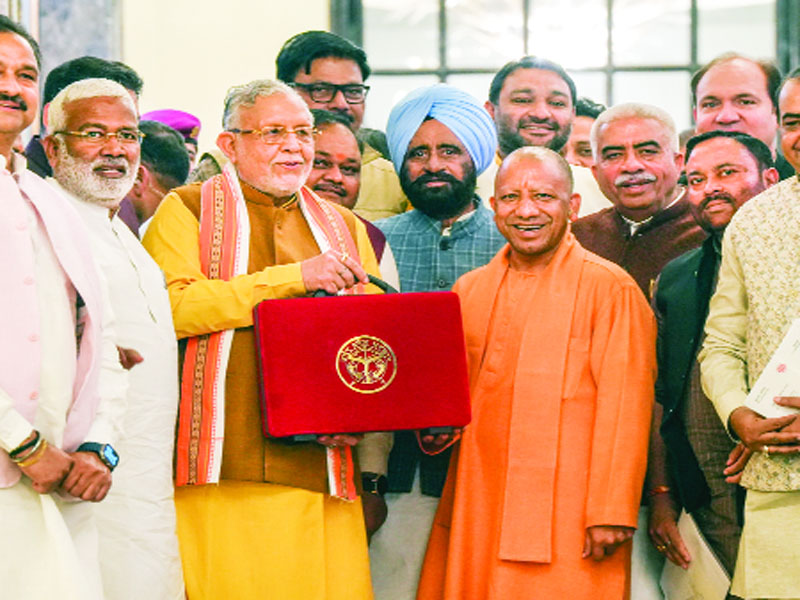LUCKNOW: Uttar Pradesh Finance Minister Suresh Kumar Khanna on Thursday presented the state budget for the financial year 2025-26, totaling Rs 8,08,736 Crore, with a strong push toward research, technology, and infrastructure development. The budget, which marks a 9.8 per cent increase over the previous year’s outlay, allocates significant funds for key sectors, including education, healthcare, and agriculture.
Highlighting the government’s vision, Khanna emphasized that 22 per cent of the total budget has been earmarked for development projects, 13 per cent for education, 11 per cent for agriculture and allied activities, and six per cent for the health sector.
“We have prioritised research, development, and IT to drive economic growth and technological innovation in the state,” said Khanna during his budget speech.
One of the major highlights of the budget is the proposal to establish an “Artificial Intelligence City,” aimed at making Uttar Pradesh a leading center for AI innovation. Additionally, a specialized Technology Research and Translation Park focusing on cybersecurity will be developed to enhance the state’s digital infrastructure.
The budget also proposes the modernization of the Uttar Pradesh Legislative Assembly with advanced IT systems. Further, smart classrooms and digital labs will be set up in schools and government polytechnics to improve access to quality education. To bolster urban development, the government has allocated Rs 145 Crore to transform 58 municipal bodies into model “Smart Urban Centers,” ensuring improved civic facilities and governance.
As part of its commitment to social welfare, the government plans to build new labor hubs at district headquarters, equipped with essential amenities such as canteens, drinking water, and sanitation facilities for construction workers. Aimed at tackling poverty, the ‘Zero Poverty Abhiyan’-launched on Gandhi Jayanti in October 2024-continues to be a key initiative. Under this campaign, the government is working to identify the poorest families in each Gram Panchayat and help raise their annual income to at least Rs 1.25 Lakh through targeted welfare programs.
Khanna underlined the state’s improving financial health, noting that Uttar Pradesh has been recognised as a “front runner” by NITI Aayog for its progress in healthcare, capital expenditure, and economic development. The state’s fiscal deficit remains under control, while efforts to increase development expenditure and reduce debt have shown positive results.
According to a Reserve Bank of India (RBI) report, Uttar Pradesh ranks among the highest states in tax revenue collection, reflecting sound financial management. The state’s economy, which faced challenges in 2017, has now doubled, with the Gross State Domestic Product (GSDP) projected to reach `27.51 Lakh crore for 2024-25. Additionally, per capita income has surged from `52,671 in 2016-17 to `93,514 in 2023-24.
The budget includes allocations for the establishment of six new forensic science laboratories in Ayodhya, Basti, Banda, Azamgarh, Mirzapur, and Saharanpur to strengthen crime investigation capabilities.
In medical education, the government has earmarked `27 Crore for an autonomous medical college in Ballia and `25 Crore for a similar institution in Balrampur, aimed at expanding healthcare services and medical training facilities in the state. For education, the state plans to introduce a new initiative offering free scooters to meritorious female students to promote higher education among women. In addition, investments will be made to enhance Science City, Science Parks, and Planetariums to encourage scientific awareness.
Chief Minister Yogi Adityanath, speaking after the budget presentation, said, “This budget is a blueprint for Uttar Pradesh’s sustainable development. We are focusing on infrastructure, technology, education, and social welfare to ensure inclusive growth and economic progress for all sections of society.”
With its ambitious plans, the Uttar Pradesh government is positioning the state for accelerated growth, leveraging technology and strategic investments to build a robust and future-ready economy.
With inputs from PTI




 Boult Expands Mustang Partnership With New Audio Lineup
Boult Expands Mustang Partnership With New Audio Lineup 